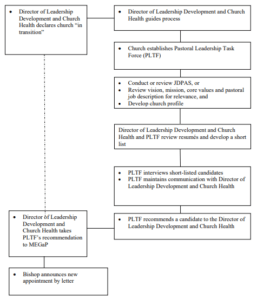¶875 POLICIES FOR PASTORAL TRANSITIONS AND APPOINTMENTS IN THE FREE
METHODIST CHURCH IN CANADA
The Free Methodist Church in Canada, through the ministerial education, guidance and placement committee, appoints pastors to local churches. While the appointment of pastors by the conference is a historical distinctive of Methodism, the process of making appointments has been modified from time to time to meet the changing needs and expectations of pastors and local churches throughout the history of the denomination.
In keeping with the expressed core values of The Free Methodist Church in Canada and the commitment to empower the local church, the process of appointment has been further modified to involve the local church in a greater and more responsible manner.
1. The director of leadership development and church health declares a pastoral transition through a letter sent to the church and pastor when:
a. The director of leadership development and church health agrees in writing to a pastor’s signed request to be released from the present appointment. The director of leadership development and church health will advise the bishop and the church. The church is to receive at least sixty days notice unless modified by an agreement signed by the director of leadership development and church health, the pastor and the delegate(s).
b. The director of leadership development and church health agrees in writing to a signed letter of request from the chair of the official board and delegate indicating that a strong majority (75%) of the official board has expressed in a recorded vote that they have lost confidence in the pastor’s capacity to lead the congregation
c. If a performance appraisal of the pastoral leader (see ¶335), based on the current official board approved job description (built locally and reflecting the current vision and stated mission) results in an overall average score below 5.5, the results will be referred to the director of leadership development and church health and the ministerial education, guidance and placement committee (MEGaP) who may declare that the church is in transition. The pastor is to receive at least sixty days’ notice unless modified by a salary continuance agreement as outlined in ¶880.
d. Disciplinary action of the bishop and MEGaP committee necessitates a transition in leadership.
e. After an appraisal, it is the opinion of the conference, through the MEGaP committee, that a transition is necessary for the health of the church, the pastor or both.
f. At the discretion of the MEGaP committee, the conference appoints a pastor to another charge. The vacancy created by such action places a church in transition.
2. Once a church has been declared in transition:
a. The local board will be instructed by the director of leadership development and church health to establish a pastoral leadership task force (PLTF) of at least four persons who:
- are members and/or preparing for membership, who have had significant involvement in the local church for more than a year.
- fairly represent the makeup of the congregation
- are committed to involvement that may last several months.
- are willing to work in co-operation with the director of leadership development and church health and the MEGaP committee.
- are not local church employees, ministerial candidates or lay ministers who are tracking for ministry within the FMCIC, members of conference or located ministers.
- The delegate(s) shall be a member of the pastoral leadership task force.
3. The director of leadership development and church health or a designee will be assigned to guide the pastoral leadership task force.
4. The first task of the pastoral leadership task force (PLTF) is to develop a church profile to be given to prospective candidates which should include:
a. A clear job description based on the current vision and stated mission approved by the official board. The Job Description Performance Appraisal System (JDPAS), a resource available from the conference at the expense of the local church, is recommended for use in evaluating the present condition of the church’s ministry and for communicating the role of the pastor to the MEGaP Committee for presentation to prospective pastors.
b. If the JDPAS process is not used, the profile must include the church’s present vision, mission, core values and pastoral job description. The pastoral job description should be built on biblical, community and congregational research.
c. A profile of the local church will also include:
– local church description (i.e., building, pastoral history, finances, staff)
– community information describing the positive life of the village, town or city
– the preparation of other proposals for pastoral leadership with supporting rationale (For example, a church may need to face the reality that they can only recommend a bi-vocational pastor to give leadership at this time.)
5. The director of leadership development and church health and/or MEGaP committee, in consultation with the PLTF, and using the summary of the profile, will develop a short list of MEGaP approved potential candidates. When a transition pastor has been appointed, he/she should not assume that he/she will be recommended as the new lead pastor. He/she may, however, be considered for short lists. The short list will contain no more than three names. Short-listed pastors will be informed by the PLTF that they are on a short list.
6. The PLTF will limit its consideration of candidates to the short list. The PLTF will develop an
appropriate interview process in consultation with the director of leadership development and church health. (See the “Transitions Handbook” available from the director of leadership development and church health’s office.) All candidates on the short list will have a first interview by telephone or in person, depending on travel distance. Further interviews, after the initial interview, may be limited to only one candidate, and not necessarily extended to all short-listed candidates. An invitation to participate in a worship service at the local church may be offered to only the final candidate.
7. During this process the chairperson of the PLTF needs to maintain clear and current communication with the candidates and the director of leadership development and church health or designate.
8. The PLTF process will eventually result in the preparation of a recommendation to the director of leadership development and church health for action by the MEGaP committee. A Letter of Understanding (¶879) will have been drafted and signed by the candidate prior to the recommendation being sent to the director of leadership development and church health. The PLTF will notify unsuccessful candidates in writing.
9. The recommendation should use the following wording: The Pastor and Board of Name Free Methodist Church, City , Province recommends to the Ministerial Education Guidance and Placement Committee that Candidate’s Name be appointed to Church name as Title of
Position effective date that the appointment should start.
Note: The assigning of a pastor’s title is the responsibility of the local church. (See Par. 374.4.) If, in the future, an appointed pastor’s title is changed because of a job description change, the local church will inform the credentialing coordinator of the FMCiC of the new title. The only exception to this is in the case of a staff pastor becoming a lead pastor (including assuming a transition lead pastor role). In this case, an appointment recommendation needs to be made to MEGaP.
10. When the MEGaP committee approves the recommendation from the PLTF, the bishop will announce the new appointment, thus completing the process. The PLTF will disband.
11. The receiving church will be responsible for the expenses incurred in the recruitment and moving of a new pastor.
Note: These are the first pages of a document that is used to coach local churches when they go into transition. These pages summarize the policies and process of pastoral transitions as practised in The Free Methodist Church in Canada. The complete Transitions Handbook is available from the FMCIC website or the director of leadership development and church health’s office. The chart on the following page summarizes the whole process.
Church in transition





